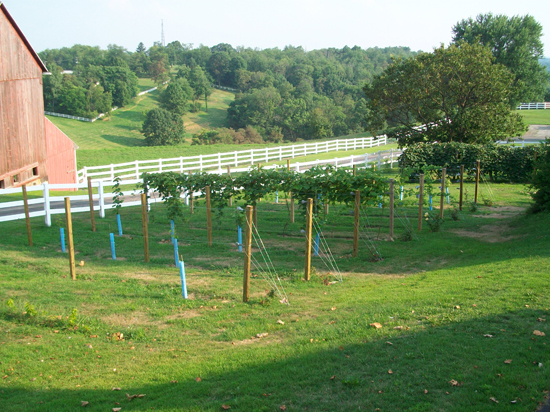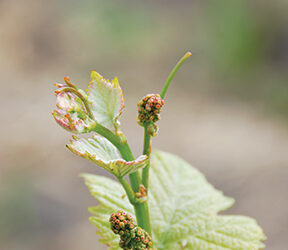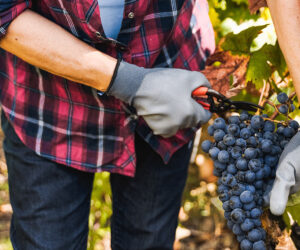
The availability of grape and fruit concentrates makes the home production of fine wines possible no matter where you live. But for some of us, the hours spent in the vineyard, orchard, and garden are as much a part of the joy of winemaking as corking the bottle and applying the label at the end of the process.
Many fruits thrive in cold regions and make fine country wines, but don’t let your climate zone discourage you from planting a few grape vines among the rhubarb and raspberries. You may not get a harvest every year, but the satisfaction of producing your own grape wine proves worthy of the challenge.
Before You Plant
Forethought and planning determine much of the success of home grape production. Before purchasing a single vine, do some homework. It may save you plenty of money, time, and frustration.
To successfully select vines, you need to know your agricultural zone rating. A zone rating is a number assigned to a specific region of land. Factors such as average minimum temperatures determine an area’s zone rating. On detailed maps, zones are subdivided into “a” and “b” classifications, “a” indicating somewhat cooler conditions.
Trees, vines, and perennial plants are also given a zone range that indicates the coolest zone possible in which they can survive and the warmest zone in which they will perform consistently. A plant rating of zone 5 to 9 indicates ability to adapt to the climate conditions in those zones.
Seed catalogs and gardening books often contain maps that give a general idea of the zone rating for your area. Your county USDA Extension Service can give you the most accurate assessment. Within each general zone, every property has its own unique adjustment factors based on wind protection, altitude (frost settles in low-lying areas first), available sunlight, and proximity to a body of water.
Knowing the length of the average growing season for your area also aids in making good choices. You might purchase a grape variety that has a hardy root, yet find you never harvest any mature grapes because the growing season isn’t long enough for that variety. Soil can be improved and adjusted in many ways, but you are stuck with the weather. Choose plant varieties that have proven themselves in your climate zone.
Become familiar with the County Extension Service. It works for the small property owner as well as the commercial grower. Your extension office offers free and low-cost publications that will tell you exactly what varieties of trees, vines, and fruits will grow best in your area. The office can provide soil analysis and other services. It knows what diseases and pests prove troublesome locally. It can advise you on the best place to plant your grapes.
Workshops and seminars on a variety of topics, including viticulture, take place throughout the year. Workshops provide opportunities to meet other large, small, and aspiring growers. Take advantage of your tax dollars. Canadians have similar resources available through provincial government offices. Country Extension offices post a variety of information on the web.
You may want to find a winemaking supply store or a food co-op and inquire about winemaking clubs in your area. Go to a meeting (or several). Ask people who are growing their own grapes what they have success with and what varieties have not proven productive. Check with local wineries, if there are any.
Having made some preliminary decisions as to what varieties will be incorporated into your growing plan, you are ready to purchase your stock. Buy from reputable local nurseries or established mail-order companies. In areas where the growing season is very short, some grape growers prefer to buy potted stock that was started in a greenhouse to transplant, as opposed to dormant bare-root stock. When you buy dormant stock, by the time you realize that the plant is dead, it is too late to replant that year, even if the stock comes with a warranty.
Don’t assume because a local business sells you a plant that it will grow in your area. The variety and hardiness zone of the vines should be clearly labeled. Beware of purchasing from national discount chain stores. You can find grape varieties being sold in local parking-lot garden centers that are rated for the completely wrong zone. They have little chance of surviving even a single winter.
In spite of the warnings, sometimes it’s easy to ignore this advice. Last fall, as an act of mercy, one grape grower bought several half-dead Niagara vines off the clearance rack at Wal-Mart. She brought them home, treated them with fungicide and insecticide, and planted them in an unheated greenhouse. They had a little time to establish and get some new growth before they froze into winter dormancy. El Niño created a mild winter and an early spring. The vines have flourished over the summer in their protected environment. Maybe, just maybe, she’ll get a few grapes off them next summer, if there is another mild winter and if the plastic doesn’t blow off the greenhouse in mid-winter or collapse with a heavy snow load. Lots of “ifs.” But those vines cost less than a dollar each (marked down from $6.97!). It’s an affordable risk.
Cultivating Grapes in Snow Country
Unfortunately, not everyone can live in California’s Napa Valley. What if you’re located right in the center of Wisconsin — a pocket that collects Arctic air masses and the area is labeled Zone 3a (the coldest zone in the continental United States)? Zone 3 has average minimum winter temperatures of -40° to -30 °F (-40 to -35 °C). What if your particular acreage sits in a windy spot with no natural protection? It would not be uncommon to have several winter days during January when the wind chill exceeds -70 °F (-57 °C). Exposed vines and branches suffer the consequences of wind chill just as your skin does.
Obviously, such extreme temperatures do not lend themselves well to grape horticulture. European (Vitis vinifera) grapes, usually winterkill at 0° to -15 °F (-18 to -26 °C). Concord experiences bud damage and injury when temperatures drop to -20 °F (-29 °C). French hybrid grapes are not hardy in zones 3 and 4 and are not suggested for extensive planting. Foch and Leon Millot are the hardiest of the French hybrids and sometimes produce in the warmer areas of zone 4. Chardonnay and a few other cultivars are possible but need to be buried every fall for winter protection and require extra care during the growing season to produce well.
In spite of this dismal picture, some American grape varieties will produce in zone 3. New ones continue to be developed. Some of the hardiest vines include: Valiant, Beta, King of the North, Suelter, Bluebell, Minnesota 78, Eona, Edelweiss, and Fredonia.
In one zone 3a vineyard, King of the North and Valiant have been successful. The four-year-old vines produced more than 35 pounds (16 kg) per vine last summer (after a mild winter). Mature vines of the hardy cultivars can be expected to produce five to 20 pounds (2.3 to 9 kg) of fruit each. A small planting of six to eight producing vines can potentially provide the home winemaker with enough grapes for a five-gallon (19-L) run.
During harvest years, you can stretch your fruit by making a “second run” of wine. Production of a second-run wine begins at the point when you remove the fermentation bag or strain the pulp out of your initial run. After the wine is racked out of the primary fermenter, the pulp/fermentation bag returns to the pail. Added recipe ingredients and grape juice concentrate fortify the must.
There are specific recipes for second-run wine to help you get started. A second run usually produces a lighter-bodied wine with less color, but the wine will mature sooner. You can get excellent results from this vineyard “recycling.”
Vineyard ABCs
Good gardening practices help increase the odds that you will actually harvest grapes from your vines. For best production:
- Choose a location that gets plenty of sun.
- Develop a workable trellis/training plan. Trellis systems for northern growers often involve growing trunks at a 45 degree angle. In the fall, vines are pruned back to eight buds, removed from their trellis, and allowed to lay on the ground. Snow cover acts as mulch and wind-chill protection. Straw and leaves attract rodents and should not be used for mulching. Some trials have shown that encouraging vines to develop double trunks lessens the chance of complete winter-kill during severe winters. Publications such as Growing Grapes in Minnesota have detailed diagrams and instructions on vine management and trellis systems for cold climates.
- Practice weed control. Weeds steal water and nutrients from the soil. A few plants of Canadian thistle or nettle in your vineyard can turn pruning and harvesting into literally painful events. A small planting can be weeded by hand, rototilled, or mulched. Mulching has an advantage of conserving moisture under the trellis. If heavy clay soil makes weeding and tilling a lot of work, you can rely primarily on herbicide sprays such as Round-up once the vines become established. (Herbicides are not recommended for first-year vines.) A number of effective herbicides are marketed that are safe for grape plantings. Again, your County Extension agent can recommend a type effective for weed control in your area.
- Have a plan for protecting vines from late spring and early fall frosts. If you can protect your immature grape crop from that first fall frost, several weeks of mild or warm weather often set in before the next killing frost occurs. Your grapes may reach maturity with a little extra care in early fall. You can cover vines with plastic sheeting, tarps, even bedding from your linen closet. Running sprinklers can be effective in reducing frost damage.
- Provide water for your vines during drought periods. This is most important for newly planted vines in their first season when roots haven’t had time to become established. For a few vines, a soaker hose works well, or give them a five-gallon pail of water a couple times a week during dry periods. Do not water with an above-ground sprinkler system on sunny days, because wet leaves can “sunburn” and the resulting damage may leave them vulnerable to disease.
- Become familiar with common grape pests and diseases and treat affected plants. Fewer diseases and pests afflict the northern zones and often prove specific to a local area. Your county probably has a publication to familiarize you with current pests and diseases. Sprays and traps provide insect control. Hardy American cultivars often prove more resistant to fungus and bacterial disease than French hybrids. Good site location and pruning to maximize air circulation in the canopy help eliminate many potential problems. Application of fungicides controls many common diseases.
- Don’t dig up what appear to be winter-killed vines too soon. If you plant vines rated for your zone, a severe winter may kill all top growth, but it is quite likely that the root will survive and send up new shoots. Those shoots may not appear until well into the summer growing season, depending on the extent of winter injury.
Realistic Expectations
In spite of your best efforts, if you live far beyond the warm, fertile valleys where Zinfandel grows, be prepared to experience years when you will not reap a harvest from your vines. It helps to keep your expectations realistic. Severe winters and unseasonable frosts do come. In years when you get a good crop, count your blessings and rejoice. In barren years take comfort — there are always fine concentrates and kits available for vinifera wines. If you end up with only a small crop, mix what you have with a purchased concentrate. You will end up with your own unique, never-to-be-duplicated vintage. And don’t forget that there are many other reliable fruits that make wonderful country wines.
Winter Winemaking
One of the challenges of living and gardening in a short-season climate is that everything needs attention at the same time. Harvest-time chores may become overwhelming, especially if you have a vegetable garden in addition to your fruits. How will you manage to harvest produce, prepare fruit, get to work every day, can the tomatoes, and start all those varieties of wines?
Fruit harvest must take place at the peak of maturity and freshness. But anytime is the time for winemaking. With a freezer (or a rented locker) you can preserve your harvest and leisurely enjoy starting your wines during the winter months as you have time and containers available.
You can freeze all of your fruit (even your grapes) in quart packages or pails. Make a few small packages of grapes, because many fruit-wine recipes call for a pound or two of grapes in addition to the primary fruit. Freezing fruit expedites the winemaking process. Fruits that have been frozen yield their juice readily upon thawing and break down more readily in the fermenting process. Freeze only prime, ripe fruit, removing bruised and overripe pieces. Frozen fruit, properly packaged, will be suitable for winemaking even after a year or more in your freezer (although the FDA doesn’t recommend fruit storage for that long).
If your winemaking cellar is very cool, even during the summer, it is a great place to make lager-style beers in the wintertime but a bit too cold for the initial stages of winemaking. You need to find ways to control the temperature for the primary fermentation process of your wines. One method is to use a warmer blanket made for a car battery, which you can find at discount hardware stores. This waterproof “heating pad” fits nicely around a five- or seven-gallon pail. Plugged into a voltage-regulator device such as a dimmer extension cord or a fan control, the blanket can be precisely regulated for warmth and so can the fermentation temperature of your must and juices. You will find other uses for this inexpensive warming system, such as providing bottom heat for starting seed flats in the spring.
Remember, winemaking ought to be a stress reliever, best indulged in during leisure times when there is little pressure to hurry. On a January morning when the wind chill is -50 °F (-46 °C), while stirring sugar into a pail of fragrant fruit in your cool basement, you will have time to remember that warm October afternoon when you picked those grapes. While the winter winds howl, and there isn’t a single sign of life in the ice-covered landscape, the fruit of seasons past is quietly fermenting and you can look forward to wine that will be shared in the garden on a future summer evening.
Winemaking, combined with fruit production, offers an enjoyable hobby that can be a lifelong learning experience. The challenges vary from region to region, cellar to cellar. Read, ask questions, and practice your craft. Feel free to experiment now and then. Wherever you live, you can grow your own fruit and make great wine!







